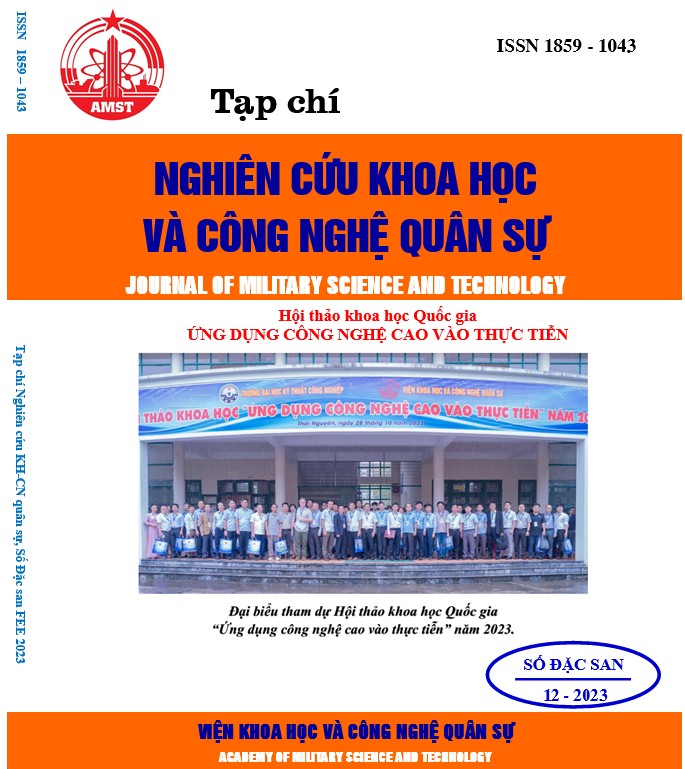Studying and surveying factors affecting the viscosity of hydrophilic-hydrophobic polymer used in enhancing oil recovery
400 viewsDOI:
https://doi.org/10.54939/1859-1043.j.mst.FEE.2023.245-250Keywords:
Polymer injection technology; Hydrophilic-hydrophobic polymer; Salt resistant; Heat resistant.Abstract
Hydrophilic-hydrophobic polymers have the potential to profoundly change the ability to enhance oil recovery in injection technology and are chosen for application as a new enhanced oil recovery method. The article mentions the results of research investigating the influence of factors on the viscosity of hydrophilic-hydrophobic polymers based on polyacrylamide (hydrophobically associating polyacrylamide-HAP) used in injection technology to enhance recovery. Oil: HAP 6S, HAP 3SP and HAP 2SP. An increase in polymer viscosity can improve the scavenging efficiency during enhanced oil recovery, the bulk viscosity of polymers is based on molecular chain extension and physical obstruction of solvated chains, viscosity solutions of synthetic polymers, studied as functions of concentration, temperature, and salinity. The research, survey, and evaluation will select the appropriate hydrophilic-hydrophobic polymer content to withstand salinity (NaCl content is about 3 - 3.5%) for immediate application on offshore drilling rigs. Heat resistant when working in high-temperature environments up to 110 oC. The results of this research are the premise for the next evaluation in the process of proposing the application of hydrophilic-hydrophobic polymers for the polymer injection process to enhance oil recovery in our country's production wells, especially in the Miocene strata.
References
[1]. Phan Vũ Anh, Kiều Anh Trung, Trịnh Thanh Sơn, Hoàng Linh Cù Thị Việt Nga, Lê Thị Thu Hường, Lê Thế Hùng. ‚“Triển vọng áp dụng các công nghệ tăng cường thu hồi dầu cho các mỏ dầu tại thềm lục địa Việt Nam”, Viện Dầu khí Việt Nam số 9, (2018).
[2]. Nguyễn Văn Hùng. “Các phương pháp tăng cường thu hồi dầu và kết quả áp dụng tại một số mỏ trên thế giới”, Đại học Dầu khí Việt Nam, số 2, (2015).
[3]. Phùng Đình Thực. “Một số giải pháp công nghệ và kỹ thuật góp phần nâng cao sản lượng giếng dầu và hệ số thu hồi dầu mỏ Bạch Hổ. Hội thảo: Nâng cao hệ số thu hồi dầu mỏ Bạch Hổ., Tập đoàn Dầu khí Việt Nam, (2002).
[4]. Nguyễn Hữu Trung và cộng sự, “Nghiên cứu khả năng ứng dụng phức hệ Polyme để bơm ép trong móng nứt nẻ tại các giếng khoan ở thềm lục địa Việt Nam nhằm nâng cao hệ số thu hồi dầu khí”, Viện Dầu khí Việt Nam, (1996).
[5]. Phạm Trường Giang, Trần Đình Kiên, Hoàng Linh, Đinh Đức Huy, Trần Xuân Quý, Phan Vũ Anh, Phạm Chí Đức, Lê Thế Hùng, Phạm Văn Tú, Trần Đăng Tú, Vương Việt Nga và Lưu Đình Tùng, “Đánh giá khả năng và xây dựng kế hoạch thử nghiệm bơm ép polymer cho tầng Miocene dưới mỏ Bạch Hổ nhằm nâng cao hệ số thu hồi dầu”, Tạp chí Dầu khí, Số 8, trang 44 - 52, (2018).
[6]. Shijie Zhu, Zhongbin Ye, Jian Zhang, Xinsheng Xue, Zehua Chen, and Zuping Xiang, “Research on optimal timing range for early polymer injection in sandstone reservoir”, Energy Reports, Vol. 6, pp. 3357 - 3364, (2020). DOI: https://doi.org/10.1016/j.egyr.2020.11.247
[7]. DOI: 10.1016/j.egyr.2020.11.247. Akstinat, M.H “Polymers for enhanced oil recovery in reservoirs of extremely high salinities and high temperatures”. Paper SPE 8979 presented at the SPE Fifth International Symposium on Oilfield and Geothermal Chemistry, Stanford, (1980). DOI: https://doi.org/10.2118/8979-MS
[8]. Chen, H., Zhang, S.H., Chu, Y.B., Yang, H.X., Liu, F.L.. “Development and application of hydrophobically associating polymer gel in high-temperature and high-salinity reservoirs for profile modification”. Oilfield Chemistry Vol. 21 (4), 343–346, (2004).
[9]. Tan H, Tam KC, Tirtaatmadja V, Jenkins RD, Bassett DR. “Extensional properties of model hydrophobically modified alkali-soluble associative (HASE) polymer solutions”. J Nonnewton Fluid Mech;92(2–3):167–85, (2000). https://doi.org/10.1016/S0377-0257(00)00093-8. DOI: https://doi.org/10.1016/S0377-0257(00)00093-8
[10]. Abdala AA. “Solution rheology & microstructure of associative polymers” Doctoral Dissertation Raleigh (USA): North Carolina State University; Vol. 6, (2002).
[11]. Tan H, Tam KC, Jenkins RD, “Rheological properties of semidilute hydrophobically modified alkali-soluble emulsion polymers in sodium dodecyl sulfate and salt solutions”, Langmuir, Vol. 3 (2000);16(13):5600–6. https://doi.org/10.1021/la991691. DOI: https://doi.org/10.1021/la991691j
[12]. Karlson L. “Hydrophobically modified polymers rheology and molecular associations”, Doctoral Dissertation Lund (Sweden): Lund University; Vol. 5, (2002).







